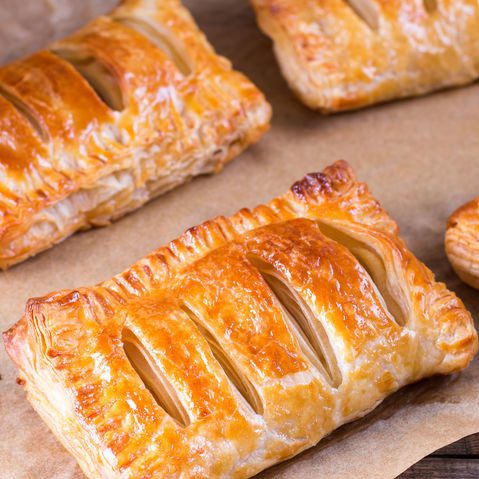
Rough Puff Pastry
What is a Rough Puff Pastry?
Rough puff pastry is also known as blitz (German for lightning) puff pastry or demi-feuilletées. It is a variation of the classic puff pastry, although less elaborate. Rough puff pastry is differentiated by:1
- A shorter processing time
- Fewer folds
- Reduced or no rest time between successive folds
Rough puff pastry does not rise as high as classic puff pastry, so it is not suitable for products where a light texture is desired. It is mostly used with layered cream fillings and meat dishes such as napoleons and beef wellington, respectively.
Origin
The origin of the puff pastry is quite unclear. While the Dictionnaire universel de cuisine credits a chef named Feuillet with its invention; other sources indicate that puff pastry was known to the ancient Greeks as shown in a charter drawn up by Robert, bishop of Amiens (1311). Despite this finding, puff pastry is known to have been brought back into fashion later by the artist, Claude Lorrain and a chef Feuillet, thus the name Pâte Feuilletée.2
How is rough puff pastry made?
Traditional puff pastry requires a block of butter to be sandwiched between two layers of dough and is then sheeted out multiple times and folded over itself to create alternating layers of dough separated by layers of fat. While this results in a very light and delicate product, it is often time-consuming and labor-intensive.
Rough puff pastry is prepared by incorporating butter or fat in the form of golf-ball size chunks into the dough, instead of the entire slabs used in classic puff pastry. This is followed by sheeting and folding with minimum or no resting time between successive folds. The result is a laminated puff pastry dough with discontinuous fat layers which bakes up into a crisp and flaky pastry structure. Addition of small amounts of lemon juice into the formula ensures dough tenderness during processing and baking.
Rough puff pastry formula:3,4
| Ingredient | Baker’s % |
| Dough | |
| Pastry flour / bread flour (or blends) | 100.0 |
| Butter | 75.0–100.0* |
| Water | 50.0 |
| Salt | 1.5–2.0 |
| Malt (non diastatic) | 1.0 |
| Lemon juice | 1.0 |
*Butter for dough is a percent of the total flour weight.
Producing a high-quality rough puff pastry requires the following steps:
- Ingredient scaling/metering
- Mixing. Dry ingredients and butter (cubes) on low speed to maintain the butter pieces intact. Add liquids and mix until a rough dough is formed.
- Allowing the dough to rest for about 20 minutes.
- Sheeting the dough to the desired thickness.
- Laminating into 4-5 single folds. For the first two folds, rest the dough for 20 minutes followed by another set of 3 and 4 folds, allowing the dough to further rest for 20-30 min. Since there is no roll-in step, the dough can directly be sheeted out into the required thickness. A series of sheeting and folding steps follow to generate the required number of layers. Folding can be accomplished in many ways. The dough may be cut and placed over another piece of dough or can be moved back and forth over a slow-moving conveyor resulting in the dough overlapping
- Once the desired number of layers is achieved, the dough is then sheeted down to around 0.6-0.8 inches and packaged.
Application
Rough puff pastry is essentially a non-uniform and inconsistent dough with fewer folds than classic puff pastry. Similar to classic puff pastry, the rough puff version can be prepared fresh or obtained as a ready-made chilled or frozen mass.
Commercially, large-scale rough puff pastry manufacture can be made in batches or using continuous production lines for their use at home or restaurants and food service establishments.
Critical aspects of puff pastry production include:
- Maintaining dough extensibility during lamination. This is done by staging two automated reduction (sheeting) and laminating lines set at 90° angle from each other to equalize directional stress in the dough.
- Ensuring the building of alternating layers of dough and fat during lamination.
- Maintaining the laminated structure during baking to entrap steam and therefore provide the lift required for the development of the crisp and light texture.
- Avoiding over mixing during lamination and breaking down the butter into chunks, risking their complete incorporation into the water-based dough. Similarly, undermixed dough will not have enough strength to hold the butter chunks or may cause large butter pockets between dough pieces.
- A low ambient temperature (10–20°C) must be maintained in the plant to prevent the fat from melting or from being too hard to mix and sheet.
References
- Suas, M. “Viennoiserie” Advanced Bread and Pastry: A Professional Approach, first printing, Delmar, Cengage Learning, 2009, pp. 476-505.
- Jones, B., and Robuchon, J.. “Puff Pastry.” New Concise Larousse Gastronomique: the Culinary Classic, Revised and Updated Edition, Hamlyn, 2007, pp. 937.
- Jones, Bridget, and Robuchon Joël. “Puff Pastry.” New Concise Larousse Gastronomique: the Culinary Classic Revised and Updated, Hamlyn, 2007, pp. 938.
- Gisslen, W. “Pastry Basics” Professional Baking, 7th edition, John Wiley & Sons, Inc., Hoboken, New Jersey, 2017, pp. 311-348.

